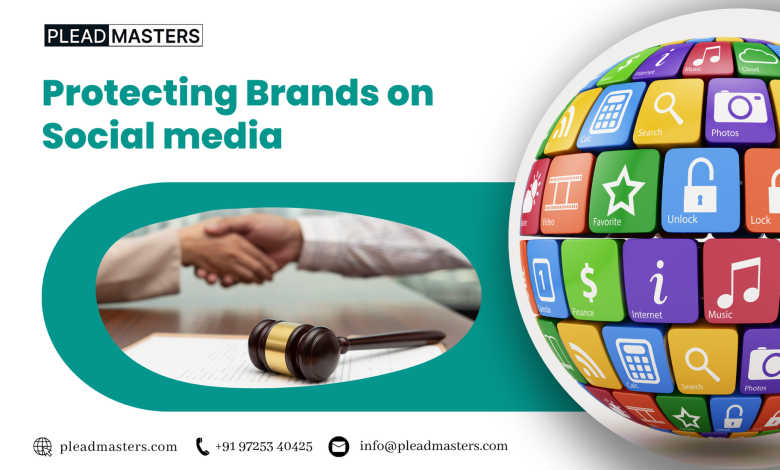Protecting Brands on Social media

Protecting brands on social media has become an essential, inseparable part of everyone’s daily life. According to a recent survey, an average person spends about 2 hours 31 minutes everyday on social media. Needless to say, brands all over the world have recognised social media as one of their favourite platforms to market any new services and products. Presence on social media platforms not only allows the brands to promote their goods and services but also to form a connection with the consumers and gain visibility. Tools such as social media marketing help brands to establish presence online but it can be misused. Any mistake committed on a social media platform, due to the very nature of the platform becomes tough to rectify and can exist forever.
To ensure protecting brands from mistakes and misuse, the following legal measures can be adopted:
- Registration of Intellectual Property (IP)
Attaining a trademark registration and copyright protection of the intellectual property owned by an organisation is one of the most important protective measures. Ensuring an IP registration, protects from the unauthorised use of the name and logo as a marketing tool. The registration grants exclusive rights to the owners of the IP and anyone who uses it without permission may be sued for IP infringement under applicable law. Additionally, it inculcates trust and authenticity in customers, increases the valuation of a company, and stops competitors from using your brand name. No formal registration of an IP leaves one with little to no recourse from the abuse and/or infringement of it and hence is the first measure to guarantee brand protection.
- Creating a Social Media Policy
In today’s day and age, leaving anything for interpretation can invite unwarranted complications at a later stage. It is highly recommended to put everything in writing and document it by way of a policy. A Social Media Policy prescribes the do’s and don’t with and on behalf of a brand’s social media.
The policy shall clearly prescribe what an employee can and cannot do, and develop an understanding of sharing content on social media. Brand aside, a social media policy must also cover the manner in which an employee has to regulate their presence on social media, represent themselves and/or the brand.
This policy is required for all businesses so as to protect their confidentiality, brand reputation. Additionally, it apprises the employees about any legal and regulatory requirements their organisation is subject to and the deliverables thereunder. Additionally, Security and Diversity considerations of an organisation are also communicated by this policy.
- Establishing an Approval Process
To ensure that the policies and regulations serve good, establishing relevant checks and balances becomes pertinent. Thus, to have an approval process in place, limits employees from posting anything and everything. Additionally, it is also important to schedule the posts, laying down the approval timeline for various departments, such as legal and also from the client (if required), to avoid any last minute hassle leading to mistakes.
Assigning roles and responsibilities, designating positions especially catering to Social Media management enhances functionality, helps resolve issues and saves time.
Appointing employees to oversee compliance helps ensure everything is right on track. Having said that, an increasing trend of employing interns and youngest people in an organisation has been observed. A common thought process behind this is that the younger generation is more tech-savvy and hence more suited for such positions. Now what is often ignored here is being tech-savvy in the usage of social media for personal use, is a lot different from using it for business and brand building purposes. The latter requires strategic insights and an understanding of business, what works, what doesn’t and most importantly what consumers find value in. Protecting brands on social media requires more than just tech skills—it demands a deep understanding of brand strategy and consumer behavior.
- The problem with negative and fake reviews
The platforms hosting reviews always provide an option to report a review, this option lets one choose from a variety of reasons including “off topic”, “conflict of interest”, “profanity”, “harassment”, “hate speech”, “discrimination” amongst others. If one fails to report a review, they may further escalate it via filling up relevant forms provided on the platform or writing to the relevant authorities in a manner that establishes your intent to protect potential customers and examine the authenticity of the concerned review.
Businesses must encourage their happy customers to leave a review. This exercise has a positive impact on potential customers as it makes them more willing to take up these services and products. Moreover, it goes a long way in making businesses willing to engage in business relationships with your organisation. Protecting brands through positive reviews can enhance your reputation and build trust.
- Educating your customers
Building a customer base also comes with a lot of responsibilities. One of them is imparting brand education, this process involves educating your customers about recognising counterfeit products. With the advent of e-commerce websites, brands struggle with loss of revenue due to the sale of counterfeit products.
Some sellers make the identification mark deceptively similar to the one rightfully owned by a brand, affix it on the counterfeit product and pass it off as original. In order to fight this, the brands must take proper measures, conduct education drives via organising webinars and seminars to make people aware of the differences between legitimate and fake products. Informing them about the legal repercussions of such malpractices shall also prove beneficial in discouraging them to seek out duplicate products.
Protecting Brands is a constant process and requires serious consideration. Social media has emerged as a great platform to market one’s products and services, build great customer relationships, and aid overall growth of an organisation.




